Learning how to mount and dismount safely and correctly is an essential skill for all equestrians, but it can be an intimidating skill to master for beginner riders. Mounting is easier to learn than dismounting—after all, you want to get on the horse so you can go riding—but with the right mindset, a cooperative horse and plenty of pointers from an experienced instructor, anyone can learn how to mount and dismount like a pro.
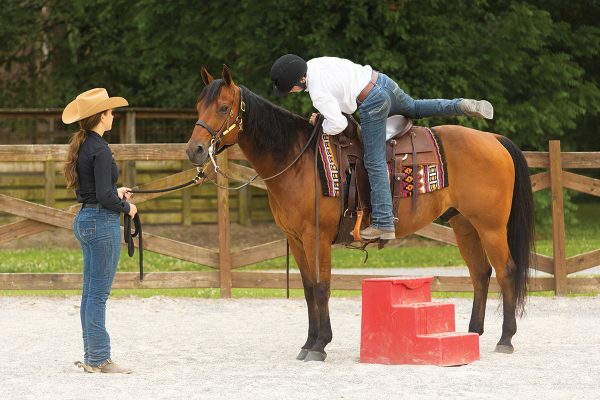
The most important thing to remember is to protect your safety, says Milly Cavender. Milly, who lives in Lynchburg, Va., is a Certified Horsemanship Association instructor as well as an experienced coach for both western and English riders.
“Safety has to be your first priority,” says Milly. “Mounting and dismounting are often the most vulnerable positions to be in around horses, because you’re in a moment of transition from being on the ground to being on the horse, and vice versa.”
TIP: When mastering mounting, it’s a good idea to use a mounting block. In addition to putting you physically closer to the stirrup, mounting from a block helps reduce strain and discomfort on your body and the horse’s back.
Up, Up and Away
Ask your instructor or another experienced rider to hold your horse for you when you’re first learning how to mount. Many horses are trained to stand quietly for mounting, but you don’t want yours accidentally walking away underneath you or swinging his hindquarters away from you while you’re getting on.
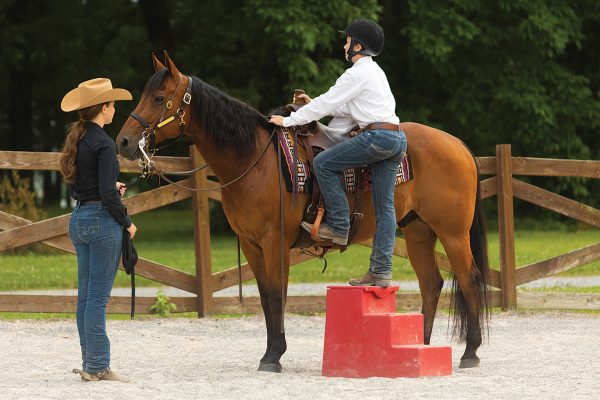
Before getting on the mounting block, perform a safety check of your tack from both sides of your horse. Start by checking the tightness of your girth right before you mount. Some girths can loosen between tacking up and when you get on, and if you don’t check, the saddle could slip as you try to mount. You want it snug enough so that the saddle will stay in place but not so snug that your horse is uncomfortable.
“Check your stirrups and make sure they’re secure on both sides,” says Milly. “Then make sure your bridle is on correctly and that the reins are not criss-crossed under the horse’s neck.”
Next, bring your mounting block to your horse’s left side. Don’t place it too far under your horse’s belly or so far away that you must reach out with your leg to put your foot into the stirrup. Once your block is in place, stand on top of the block, facing your horse’s left side.
“This is a good time to practice gathering your reins and figuring out where to put your hands on the saddle,” Milly says. “I prefer for my riders to place their left hand on the reins and to hold some mane in that same hand so that they aren’t pulling on the horse’s mouth. Then I want your right hand to be on the pommel or horn. That way, you can balance a little on your hands while you’re mounting, but you aren’t restricting your seat and leg as you swing your leg up and over the back of the horse.”
Correct placement of your foot in the stirrup is important. Many iders want to place their foot too far forward in the stirrup or too far back. Too far forward is a safety concern, because if you were to fall, your foot could get caught in the stirrup. Too far back means that your foot may slip out as you’re mounting, and that can also cause you to have an accident.
“The ideal placement is for the bar of the stirrup to be underneath the ball of your foot,” Milly says.
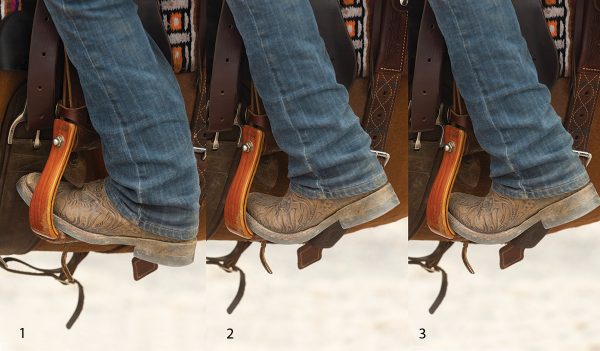
If you’re struggling to get your foot into your stirrup, ask your handler to hold the stirrup steady for you. Once your hands and left foot are in position, gently press your weight into the stirrup while you bring your right leg up and over the horse’s back, then lower yourself softly into the saddle. Take a moment to position your right foot correctly in the right stirrup and gather your reins in your hands.
Lastly, stand up in the stirrups with your heels down to confirm that your stirrups are even and the right length for your legs. If you’re having trouble standing, they may be too long for you. If your legs feel too folded up underneath you, they may be too short. Ask your handler or instructor to help you assess your stirrups for evenness and length.
Level Up!
Once you’ve mastered the art of mounting from the block, start learning to mount and dismount from the ground. It’s a handy skill to have when you’re out trail riding or any time you find yourself needing to mount without a block.
“The mechanics of mounting and dismounting from the ground are the same as with a block, but you have to develop a lot more push from your right leg to get yourself up and over the horse,” says Milly Cavender, a Certified Horsemanship Association instructor. “You also need more quad strength in your left leg. Building strength and fitness is important for this skill.”
Strong quadriceps and glutes can help make mounting and dismounting easier. Practice squats and lunges to help develop strength in your lower body. Core exercises can also boost your riding fitness.
“Anything that has to do with horses requires core stability,” says Milly. “Your core is what provides you with stability in the saddle and while mounting and dismounting. Planking is a good exercise for that, because it’s a whole-body workout. It works your back, your core, and your shoulders. And the more balanced you can be in your body, the easier it will be to perform maneuvers like mounting and dismounting, which aren’t natural for us.”
Experienced riders should also consider learning to mount their horses from both the left and right sides. It is traditional for equestrians to mount from the left side, and that’s how most horses are trained. However, there may be times, such as on a trail ride, when mounting from the right side is your only option. Ask your instructor to help you with this skill, especially if your horse is not experienced with being mounted from the right.
Now How Do I Get Down?
To dismount your horse, stand up in your stirrups. Then lean your left hand—while holding the reins and some mane—on the neck of the horse, just in front of the saddle. Place your right hand on the pommel or horn of the saddle. Then take your right foot out of the stirrup and swing your right leg gently up and over the back of your horse until both legs are on the left side of your horse.
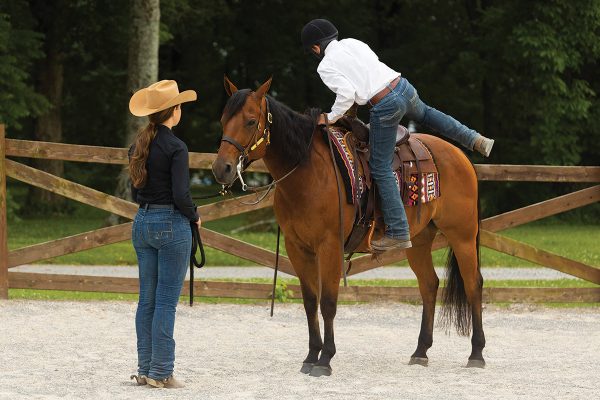
“At that point, you can lean your weight a little bit over the seat of the saddle to help you, but you should primarily lean into your hands,” Milly says. “Then take your left foot out of the stirrup. Now, as you prepare to slide down, turn your body so that you’re facing toward your horse’s head. Then slide down on your right hip.”
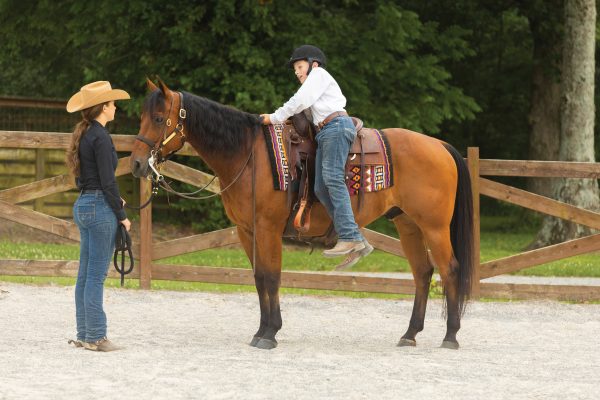
Sliding down off the horse on your right hip, as opposed to facing the horse, decreases the chances of getting your clothing hung up on the saddle. It also makes it easier for you to step quickly away from your horse once you’ve dismounted in case the horse makes any sudden movements.
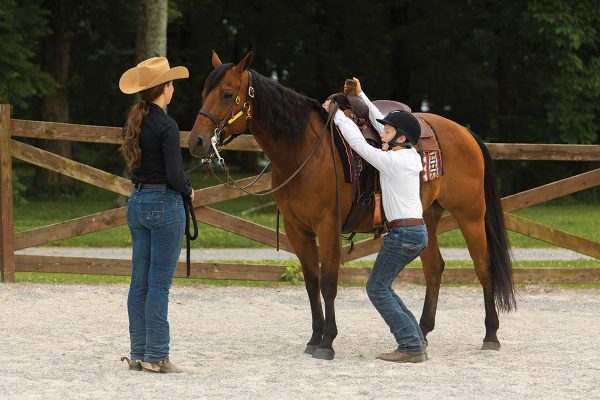
As you descend, keep a little bend in your knees so that you can catch yourself on the ground without losing your balance. Now you can mount and dismount a horse like a pro!
This article how to mount and dismount a horse appeared in the Fall 2021 issue of Young Rider magazine. Click here to subscribe!


